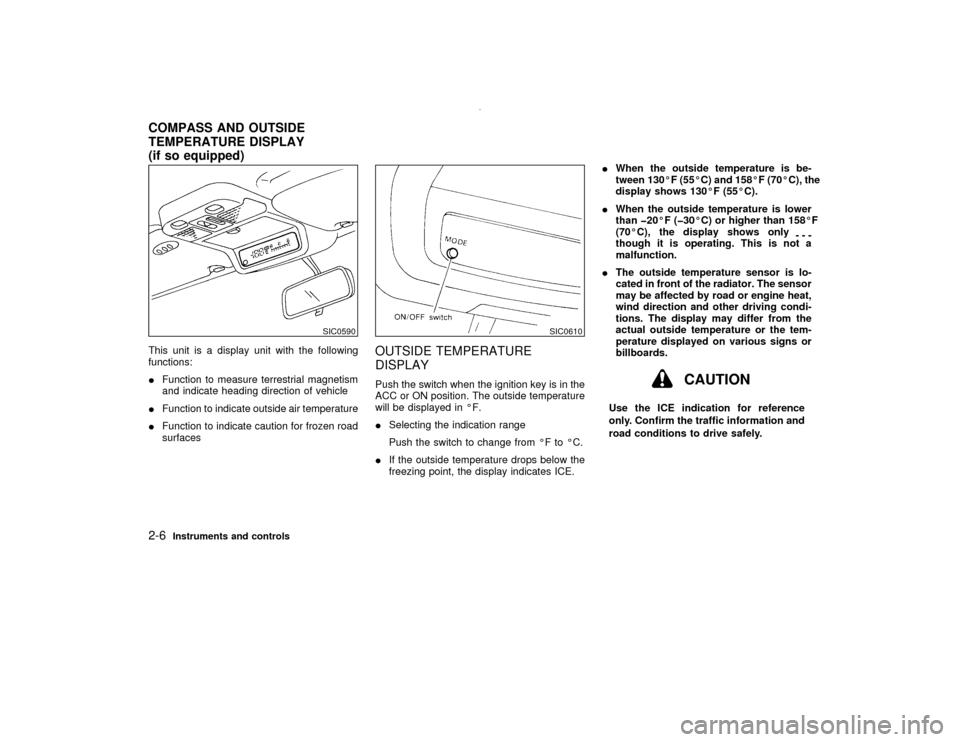air condition NISSAN PATHFINDER 2001 R50 / 2.G Owners Manual
[x] Cancel search | Manufacturer: NISSAN, Model Year: 2001, Model line: PATHFINDER, Model: NISSAN PATHFINDER 2001 R50 / 2.GPages: 289, PDF Size: 2.45 MB
Page 6 of 289

Table of
Contents
Seats, restraints and supplemental air bag systemsInstruments and controlsPre-driving checks and adjustmentsHeater, air conditioner and audio systemsStarting and drivingIn case of emergencyAppearance and careDo-it-yourselfMaintenanceTechnical and consumer informationIndex
Z
00.1.10/R50-D/V5
X
Page 23 of 289

Supplemental front air bag systemThe driver supplemental air bag is located in
the center of the steering wheel; the front
passenger supplemental air bag is mounted in
the dashboard above the glove box. These
systems are designed to meet optional certifi-
cation requirements under U.S. regulations.
They are also permitted in Canada. The op-
tional certification allows front air bags to be
designed to inflate somewhat less forcefully
than previously.However, all of the informa-
tion, cautions and warnings in this manual
still apply and must be followed.The front
air bags are designed to inflate in higherseverity frontal collisions, although they may
inflate if the forces in another type of collision
are similar to those of a higher severity frontal
impact. They may not inflate in certain frontal
collisions. Vehicle damage (or lack of it) is not
always an indication of proper supplemental
air bag operation.
When the supplemental front air bag inflates, a
fairly loud noise may be heard, followed by
release of smoke. This smoke is not harmful
and does not indicate a fire, but care should be
taken not to inhale it, as it may cause irritation
and choking. Those with a history of a breath-
ing condition should get fresh air promptly.Supplemental front air bags, along with the
use of seat belts, help to cushion the impact
force on the face and chest of the occupant.
They can help save lives and reduce serious
injuries. However, an inflating front air bag
may cause facial abrasions or other injuries.
Front air bags do not provide restraint to the
lower body.
The seat belts should be correctly worn and
the driver and passenger seated upright as far
as practical away from the steering wheel or
dashboard. Since the supplemental front air
bag inflates quickly in order to help protect the
occupant, the force of the front air bag inflating
can increase the risk of injury if the occupant is
too close to or is against the air bag module
during inflation.
The air bags will deflate quickly after a collision
is over.
After turning the ignition key to the ON
position, the supplemental air bag warning
light illuminates. The supplemental air bag
warning light will turn off after about 7
seconds if the system is operational.
SSS0138B
1-16
Seats, restraints and supplemental air bag systems
Z
00.1.10/R50-D/V5
X
Page 25 of 289

Supplemental side air bag system (if
so equipped)The supplemental side air bags are located in
the outside of the seatback of the front seats.
The supplemental side air bag (on the driver or
front passenger seat) is designed to inflate in
higher severity side collisions, although it may
inflate if the forces in another type of collision
are similar to those of a higher severity side
impact. It is designed to inflate on the side
where the vehicle is impacted. It may not
inflate in certain side collisions. Vehicle dam-
age (or lack of it) is not always an indication of
proper supplemental side air bag operation.When the supplemental side air bags inflate, a
fairly loud noise may be heard, followed by
release of smoke. This smoke is not harmful
and does not indicate a fire, but care should be
taken not to inhale it, as it may cause irritation
and choking. Those with a history of a breath-
ing condition should get fresh air promptly.
Supplemental side air bags along with the use
of seat belts, help to cushion the impact force
on the head and chest of the front occupants.
They can help save lives and reduce serious
injuries. However, an inflating side air bag may
cause abrasions or other injuries. Side air
bags do not provide restraint to the lower body.
The seat belts should be correctly worn and
the driver and passenger seated upright as far
as practical away from the supplemental side
air bags. Since the side air bags inflate quickly
in order to help protect the front occupants, the
force of the side air bag inflating can increase
the risk of injury if the occupant is too close to
or is against the side air bag module during
inflation. The side air bags will deflate quickly
after the collision is over.
After turning the ignition key to the ON
position, the supplemental air bag warning
light illuminates. The supplemental air bag
warning light will turn off after about 7
seconds if the system is operational.
WARNING
IDo not place any objects near the
seatback of the front seats. Also, do
not place any objects (an umbrella,
bag, etc.) between the front door fin-
isher and the front seat. Such objects
may become dangerous projectiles
and cause injury if the supplemental
side air bag inflates.
IRight after inflation, several side air
bag system components will be hot.
Do not touch them; you may severely
burn yourself.
INo unauthorized changes should be
made to any components or wiring of
the supplemental side air bag sys-
tem. This is to prevent accidental
inflation of the side air bags or dam-
age to the side air bag system.
IDo not make unauthorized changes
to your vehicle's electrical system,
suspension system or side panel.
This could affect proper operation of
the side air bag system.
SSS0165
1-18
Seats, restraints and supplemental air bag systems
Z
00.1.10/R50-D/V5
X
Page 27 of 289

types of collisions, thereby restraining seat
occupants.
The pre-tensioner is encased with the seat
belt's retractor. These seat belts are used the
same as conventional seat belts.
When the pre-tensioner seat belt activates,
smoke is released and a loud noise may be
heard. The smoke is not harmful, but care
should be taken not to inhale it as it may cause
irritation and choking. Those with a history of
breathing condition should get fresh air
promptly.
If any abnormality occurs in the pre-tensioner
system, the supplemental air bag warning light
will not come on, will flash intermittently
or will turn on for 7 seconds and remain on
after the ignition key has been turned to the
ON or START position. In this case, the pre-
tensioner seat belt may not function properly.
The system should be inspected by an autho-
rized NISSAN dealer.
When selling your vehicle, we request that you
inform the buyer about the pre-tensioner seat
belt system and guide the buyer to the appro-
priate sections in this Owner's Manual.
SUPPLEMENTAL AIR BAG
WARNING LABELSWarning labels about the supplemental air bag
system and supplemental side air bag system
are placed in the vehicle.
SSS0139A
1-20
Seats, restraints and supplemental air bag systems
Z
00.1.10/R50-D/V5
X
Page 28 of 289

SUPPLEMENTAL AIR BAG
WARNING LIGHTThe supplemental air bag warning light, dis-
playing
in the instrument panel, monitors
the circuits of the supplemental front air bag
and supplemental side air bag systems, and
pre-tensioner seat belt. The circuits monitored
by the air bag warning light are the diagnosis
sensor unit, satellite sensors, front air bag
modules, side air bag modules, pre-tensioner
seat belt and all related wiring.
After turning the ignition key to the ON posi-
tion, the air bag warning light illuminates. The
supplemental air bag warning light will turn offafter about 7 seconds if the systems are
operational.
If any of the following conditions occurs, the
supplemental front air bag and supplemental
side air bag systems and pre-tensioner seat
belt need servicing:
IThe supplemental air bag warning light
remains on after approximately 7 seconds.
IThe supplemental air bag warning light
flashes intermittently.
IThe supplemental air bag warning light
does not come at all.
Under these conditions, the supplemental front
air bags, supplemental side air bags and/or
pre-tensioner seat belt may not operate prop-
erly. It must be checked and repaired. Take
your vehicle to the nearest authorized NISSAN
dealer.
WARNING
If the supplemental air bag warning light
is on, it could mean that the supplemen-
tal front air bag system or supplemental
side air bag system will not operate in anaccident.
Repair and replacement procedureThe supplemental front air bags and supple-
mental side air bags are designed to inflate on
a one-time-only basis. As a reminder, unless
they are damaged, the supplemental air bag
warning light will remain illuminated after infla-
tion has occurred. Repair and replacement of
the supplemental systems should be done
only by authorized NISSAN dealers.
To ensure long-term functioning, the sys-
tems must be inspected 10 years after the
date of manufacture noted on the certifica-
tion label located on the driver side center
pillar.
When maintenance work is required on the
vehicle, the supplemental front air bags,
supplemental side air bags and related parts
should be pointed out to the person conducting
the maintenance. The ignition key should al-
ways be in the LOCK position when working
under the hood or inside the vehicle.
SPA1097
Seats, restraints and supplemental air bag systems
1-21
Z
00.1.10/R50-D/V5
X
Page 55 of 289

Driver's supplemental air bag (P.1-10)Cruise control
switch (P.5-17)
Outside mirror remote control
(P.3-15) Headlight/dimmer/turn signal switch (P.2-19)
Front fog light switch (P.2-23)
Steering switch for audio control
(P.4-25)Meters/gauges (P.2-3)Windshield
and rear
window wiper/
washer
switch
(P.2-18)
Hazard warning
flasher switch
(P.2-23)Center ventilator (P.4-2)
Heater/air conditioner control (P.4-2)Compass/outside air temperature display (P.2-6)
Passenger supplemental air bag (P.1-10)
Side ventilator (P.4-2)
Glove box (P.2-29)
Power outlet (P.2-25) or Cigarette lighter (P.2-26)
Radio (P.4-11)/CD player (P.4-13) or Navigation system* Glass hatch/
outside mirror
defogger switch
(P.2-19) Ignition switch/steering
lock (P.5-6)
Heated seat switch (P.2-24)
or 4WD shift switch (P.5-24) Tilting steering wheel
adjust lever (P.3-14) Fuse box cover (P.8-25)/
Tray (P.2-27)Clock (P.2-25)
Instrument brightness control
(P.2-21)
SIC1438
See the page indicated in parentheses for operating details.
*: Refer to the separate Navigation System Owner's Manual.
Security indicator
light (P.2-15)
Hood release handle (P.3-9)Heated seat switch (P.2-24) (4WD shift switch equipped models)
INSTRUMENT PANEL2-2
Instruments and controls
Z
00.1.10/R50-D/V5
X
Page 59 of 289

This unit is a display unit with the following
functions:
IFunction to measure terrestrial magnetism
and indicate heading direction of vehicle
IFunction to indicate outside air temperature
IFunction to indicate caution for frozen road
surfaces
OUTSIDE TEMPERATURE
DISPLAYPush the switch when the ignition key is in the
ACC or ON position. The outside temperature
will be displayed in ÉF.
ISelecting the indication range
Push the switch to change from ÉF to ÉC.
IIf the outside temperature drops below the
freezing point, the display indicates ICE.IWhen the outside temperature is be-
tween 130ÉF (55ÉC) and 158ÉF (70ÉC), the
display shows 130ÉF (55ÉC).
IWhen the outside temperature is lower
than þ20ÉF (þ30ÉC) or higher than 158ÉF
(70ÉC), the display shows only
---
though it is operating. This is not a
malfunction.
IThe outside temperature sensor is lo-
cated in front of the radiator. The sensor
may be affected by road or engine heat,
wind direction and other driving condi-
tions. The display may differ from the
actual outside temperature or the tem-
perature displayed on various signs or
billboards.
CAUTION
Use the ICE indication for reference
only. Confirm the traffic information and
road conditions to drive safely.
SIC0590
SIC0610
COMPASS AND OUTSIDE
TEMPERATURE DISPLAY
(if so equipped)2-6
Instruments and controls
Z
00.1.10/R50-D/V5
X
Page 65 of 289

4WD warning light (model)
The four wheel drive warning light comes on
when the key switch is turned to ON. It turns off
soon after the engine is started.
If the engine or vehicle is not functioning
properly, the warning light will either remain
illuminated or blink. See ª4WD warning lightº in
the ª5. Starting and drivingº section.
CAUTION
IIf the warning light comes on or
blinks during operation, have your
vehicle checked by an authorized
NISSAN dealer as soon as possible.
IDo not drive on dry hard surface
roads in the 4H or 4LO position. If the
4WD warning light turns on when you
are driving on dry hard surface roads
Iin the AUTO or 4H position, shift
the 4WD shift switch to 2WD.
Iin the 4LO position, stop the ve-
hicle, move the automatic trans-
mission lever to the N position,and shift the 4WD shift switch to
2WD.
If the warning light is still on after the
above operation, have your vehicle
checked by an authorized NISSAN
dealer as soon as possible.
Low fuel warning light
This light comes on when the fuel in the tank is
getting low. Refuel as soon as it is convenient,
preferably before the fuel gauge reaches E.
There will be a small reserve of fuel remain-
ing in the tank when the fuel gauge needle
reaches E.
Low washer fluid warning
light (Canada only)
This light comes on when the washer fluid in
the washer tank is at a low level. Add washer
fluid as necessary. See ªWindow washer fluidº
in the ª8. Do-it-yourselfº section.
Seat belt warning light and
chime
The light and chime remind you to fasten seat
belts. The light illuminates whenever the igni-tion key is turned to ON, and will remain
illuminated until the driver's seat belt is fas-
tened. At the same time, the chime will sound
for about six seconds unless the driver's seat
belt is securely fastened.
See ªSeat beltsº in the ª1. Seats, restraints and
supplemental air bag systemsº section for pre-
cautions on seat belt usage.
Supplemental air bag warning
light
After turning the ignition key to the ON posi-
tion, the supplemental air bag light will illumi-
nate. The supplemental air bag warning light
will turn off after about 7 seconds if the supple-
mental front air bag and supplemental side air
bag systems and pre-tensioner seat belt are
operational.
If any of the following conditions occur, the
supplemental air bag and pre-tensioner seat
belt need servicing and your vehicle must be
taken to your nearest authorized NISSAN
dealer.
IThe supplemental air bag warning light
remains on after approximately 7 seconds.
IThe supplemental air bag light flashes in-
termittently.
2-12
Instruments and controls
Z
00.1.10/R50-D/V5
X
Page 79 of 289

The power outlet is for powering electrical
accessories such as cellular telephones.
CAUTION
IUse caution as the outlet and plug
may be hot during or immediately
after use.
IThis power outlet is not designed for
use with a cigarette lighter unit.
IDo not use with accessories that ex-
ceed a 12 volt, 120W (10A) power
draw. Do not use double adapters or
more than one electrical accessory.
IUse only one power outlet at a time.
IUse this power outlet with the engine
running. (If the engine is stopped,
this could result in a discharged bat-
tery.)
IAvoid using when the air conditioner,
headlights or rear window defogger
is on.
IBefore inserting or disconnecting a
plug, be sure to turn off the powerswitch of electrical accessory being
used or the ACC power of the vehicle.
IPush the plug in as far as it will go. If
good contact is not made, the plug
may overheat or the internal tempera-
ture fuse may blow.
IWhen not in use, be sure to close the
cap. Do not allow water to contact the
socket.
SIC0685B
CIGARETTE LIGHTER AND
ASHTRAY (if so equipped)
2-26
Instruments and controls
Z
00.1.10/R50-D/V5
X
Page 115 of 289

Foldable outside mirrorsPush the mirror backward to fold it.
AUTOMATIC SEAT POSITIONER
OPERATIONThis system is designed so that the driver's
seat will automatically move when the auto-
matic transmission selector lever is in the P
(Park) position. This allows the driver to get
into and out of the driver's seat more easily.
When one of the following conditions is met,
the driver's seat will slide backward:
IWhen the key is removed from the ignition
switch.
IWhen the driver's door is opened with the
key turned to ACC or LOCK.
IWhen the key is turned from ON to LOCK
with the driver's door open.
When one of the following conditions is met,
the driver's seat will return to the positions
before being set.
IWhen the key is inserted into the ignition
switch.
IWhen the driver's door is closed with the
key turned to ACC or LOCK.
IWhen the key is turned to ON.Procedure for storing memoryTwo positions can be stored in the automaticdrive positioner memory.Follow these proce-
dures to use the memory system.
1. Set the automatic transmission selector le-
ver to the P (Park) position.
2. Turn the ignition ON.
3. Adjust the driver's seat and steering column
to the desired positions by manually oper-
ating each adjusting switch. For additional
information, see ªSeatsº in the ª1. Seats,
restraints and supplemental air bag sys-
temsº section and ªSteering wheelº earlier
in this section.
During this step, do not turn the ignition to
M008
SPA1164
AUTOMATIC SEAT POSITIONER
(if so equipped)
3-16
Pre-driving checks and adjustments
Z
00.1.10/R50-D/V5
X